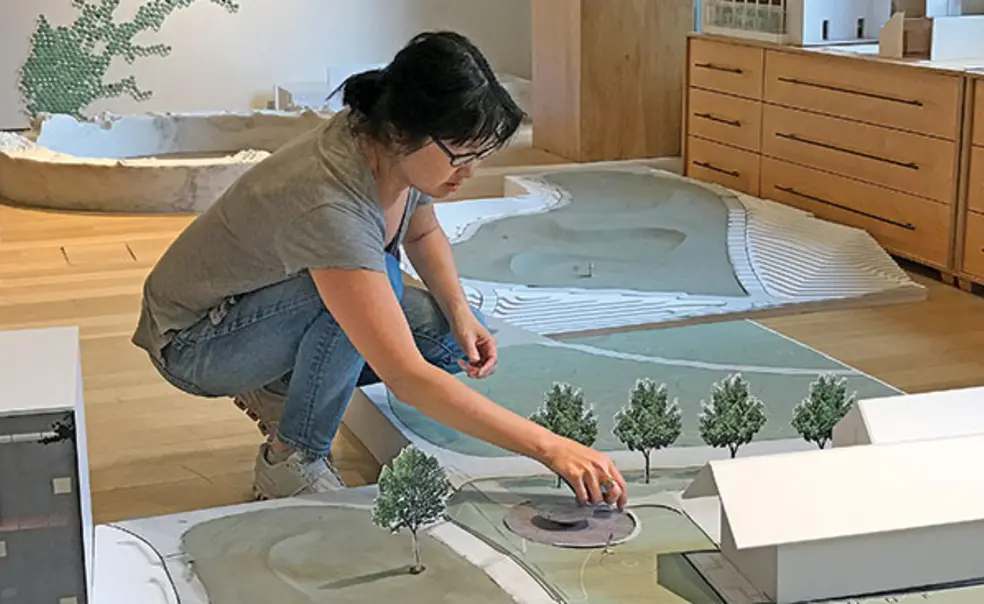Maya Lin’s Campus Project Transforms an Overlooked Site into a Work of Art
Making art for ‘the child in all of us’
Students in Professor John McPhee ’53’s “Creative Non-Fiction” course met with artist and architect Maya Lin as she visited campus to view her landscape work in progress near the Lewis Arts complex. Allie Spensley ’20 reports on the visit.
Her rain boots planted on furrows of mud, surrounded by architects, traffic cones, and 16 sophomores holding notebooks, Maya Lin is in her element.
An internationally renowned designer, architect, and sculptor, Lin is on Princeton’s campus to create an outdoor installation between the Lewis Arts complex, New South, and Baker Rink. She is also taking time to speak to John McPhee’s journalism class about the piece and her work in general.
On a Wednesday morning in early April, our meeting begins with a rapid-fire tour of what will eventually become an elegant landscape piece, but currently resembles the chaos of a strip-mall construction zone. A Caterpillar bulldozer stands by the fence; raw red wires emerge haphazardly from an upright metal pole. Strips of pink and orange tape demarcate the edges of the earthwork’s sloping structure, while wooden stakes represent the future placement of magnolia trees.
Lin has spent the day bouncing from the enclosed site to several different aerial views from the top floors of nearby buildings. The bulldozer is her chisel, the team on the ground coming together to help her shape reality according to the two- and three-dimensional models she has prepared.
These models depict a kind of serpentine hill, a tree-studded undulation of the earth that bridges the vertical distance between a nearby road and the Lewis Arts tower. The practical aim is to provide a space for recreation, outdoor classes, and performances; the artistic goal is to make the installation inseparable from the landscape itself. Sand and dirt and grass are shaped into “one continuous drawn line,” shaded by the magnolias that “soldier” past. The result is an elevation of this stray piece of land into a work of art that calls to be interacted with and experienced. “Spaces that are what I would call overlooked are of great interest to me,” Lin says.
In the fall, the larger installation will be accompanied by a second work: a water table based on Einstein’s concept of a black hole. Jet Mist granite, a dark stone swirled with nebulous patterns, will form a funnel placed on top of a boulder.
Lin has said that she makes art for “the child in all of us,” and the energy she carries with her is almost childlike in its relentlessness. She is quick to laugh and move, striding through the installation site while keeping up an almost constant stream of narration. Our group heads to a classroom on the sixth floor of the arts tower to continue our conversation.
From this vantage point, the site’s wooden stakes seem precariously thin, the pink tape like a bright vein running through the sand. You have to wonder how Lin can look at the clump of dirt below and determine minute changes to the future earthwork’s structure.
Perhaps this can be attributed to an innate artistic ability. Lin, after all, designed the world-famous Vietnam Veterans Memorial in Washington, D.C., while still an undergraduate at Yale. Ever since, she has shown an uncanny ability to design structures that tap into deep emotional undercurrents. In some of her pieces, like the Civil Rights Memorial in Montgomery, Ala., the creation of this effect stems from months or even years of research and reading. As opposed to her architecture, in her artwork — including the installation at Princeton — Lin does not use background research to shape her design. Despite their differences, however, almost all of her work is drawn from the same artistic vein: an intense fascination with the natural environment.
Lin grew up in Athens, Ohio, in a house on the edge of the woods. The close presence of nature was a constant, almost tangible feeling. As a nascent environmentalist in middle school, Lin could be found in the Kroger’s parking lot brandishing protest signs to Save the Whales and Ban Steel Traps. Her ethnic identity, too, has had a formative influence on her work; she grew up as the child of Chinese immigrants in an almost all-white town. Looking back on her career so far, Lin sees Asian influences in the meditative and educational aesthetic of her work. Within this dual nature of her identity, she has learned to thrive in the in-between: where sculpture meets architecture, where left-brain creativity meets right-brain rationality, where science meets art.
Throughout our conversation, Lin speaks about art — her own and others’ — in casually eloquent terms. To describe her series of earthworks, which includes the Princeton installment, Lin uses words like “fluidity” and “dynamism” and “motion.” These pieces are less a reimagining of the existing landscape than an extension of it. They are characterized by their capacity for human interaction — they are meant to be touched, walked on, experienced. Shadowed by the arts tower, a loudly man-made building of pale concrete and stone, Lin’s creation will be “a quiet ordering of the natural world.”
When you visit the site, you will start at the bottom and follow a curve of earth as oddly inevitable as the plot of a dream, until you are standing at the top of the hill and looking down, suddenly aware that your entire perspective has changed without you even realizing it.












1 Response
Diane Pleninger w'50
7 Years AgoPicturing Athens, Ohio
Athens, Ohio, where Maya Lin grew up, is home to Ohio University, “a large public research university” per Wikipedia. I have trouble fitting this picture into the frame provided by your reporter -- “an almost all-white town.”